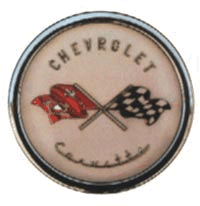1951-1963
The Era of
Performance Begins
In 1951 Harley
Earl assigned General Motors' stylist Bob McLean to design a
sports car for Chevrolet. Little did they know the car they were
designing would take off and become the icon that the Corvette is
today. In April of 1952 they completed a full size plaster model
of the car and in June of the same year presented it to the
General Motors executives. It was slated to make its debut at the
1953 Motorama Auto Show.
It was soon named the "Corvette."
Because of the notoriety the Corvette received at the Motorama
Car Show, it was soon slated for production. The factory in
Flint, Michigan was chosen to be the place where the new car, the
1953 Chevrolet
Corvette would be hand-built.
In 1953 Zora
Arkus-Duntov joined the Corvette design team and brought with
him ideas of a faster, stronger and better handling sports car.
The 1954 version
of the car was quite similar to the '53 offering, save a few body
adjustments and fine-tuning. The real change came in 1955, when the
effects of Arkis-Duntov were felt. The car featured many
performance tweakings and some new power under the hood.
Following the changes under the hood in '55, 1956 saw the
first real redesign of the exterior. 1956 also saw some
accomplishments on the track for the Corvette as well.
Arkus-Duntov set the two-way record at Daytona with the speed of
150.583 MPH. Also, the Corvette set the production car speed
record with a speed of 145.543 mph. The Corvette won its first
national title at the Seattle Seafair race in '56, in a
production car driven by Richard Thompson.

1958 was a banner year for the Corvette. It was the first year
that enough models were sold (9168) to turn a profit for the car.
Also, one of the two Corvettes entered in the Sebring Grand Prix
of Endurance placed first in the GT class. At the General Motors
Proving Ground in Phoenix, Arizona, Arkus-Duntov ran the Corvette
SS to 183 mph. Also, a few styling and performance changes were
in order for the 1958
Chevrolet Corvette. Not too much changed going into 1959. The '59
version of the popular sports car was slightly tweaked, with
minor exterior and control panel adjustments.
The real news in '59 was the debut of the Stingray. Brought
out at the President's Cup Race at Maryland's Marlboro Raceway,
the Stingray was based on the Corvette SS chassis and a
redesigned body styling. It would be a few years until the car
was introduced to the public.
Once again, the 1960 Corvette
was not very much different from the offering of the previous
years. New colors were available and a new suspension made
handling better. The real news of 1960 was that sales reaching
the 10,000 mark. This number was a sure sign that the Corvette
was becoming part of American culture. Proof of America's
obsession with the car was the start of the hit television show,
Route 66. It featured two men driving around the country in a
1960 'Vette.
The Corvette was still gaining notoriety on the racetrack. At
the Twelve Hours of Sebring three Corvettes showed: one Corvette
won the race and others came in second and third in the GT class
in 1960. Once again, in 1961 a Corvette
finished first in the GT class and eleventh overall at the race.
1962
marked the end of an era. In '63 a redesigned body would debut.
However, the engineers did not make the '62 version of the 'Vette
without some slight changes inside and out. '62 also saw the
'Vette continue to dominate at the Sebring race and also wins at
Daytona Continental and Los Angeles Time-Herald Three-Hour
Invitational Grand Prix (this win was with the 1963 model).
1963 was
the first year that the Corvette got a major overhaul. A new body
design was introduced - in convertible and coupe versions. The
design - the Stingray - was sleeker and trimmer, going along with
the changes of the times. Some performance tweaks were made as
well.
Even though the original design of the Corvette changed, the
idea behind it stayed the same. It started as a sports car for
the American people and it still is. As people grew more
accustomed to speed and more power under the hood, Chevrolet gave
them what they wanted. As people started to use the open roads
more and spread out beyond the city, the Corvette grew in
popularity and appeal. The nation itself was undergoing changes
in '63 - the Civil Rights movement was heating up, Kennedy would
be assassinated that October (marking the end of the fifties
era)...the Corvette redoing its design was just a symbol of this
change.